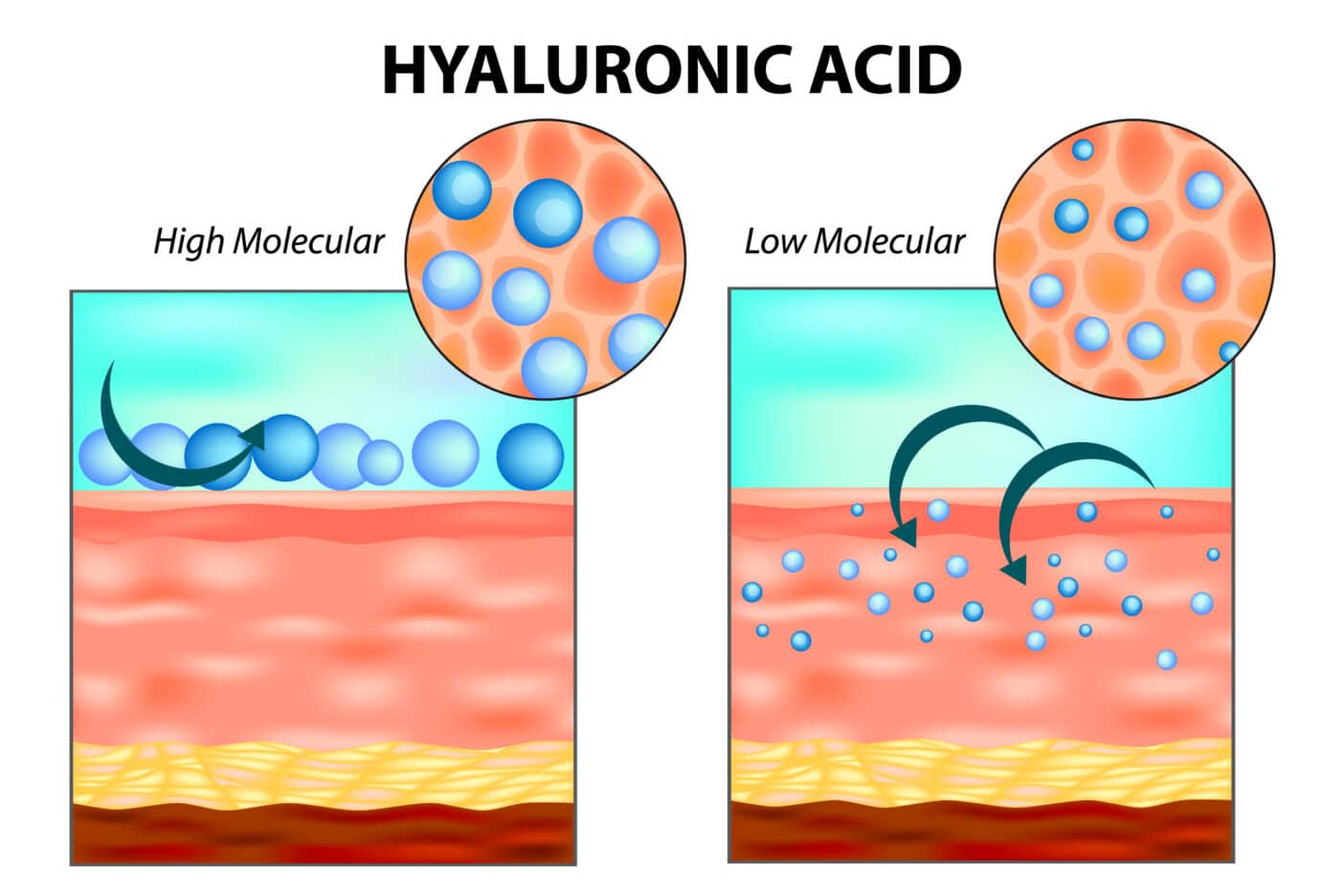Oligo hyaluronic acid

By now, everyone knows that there are different types of hyaluronic acid-like oligo hyaluronic acid or “normal” sodium hyaluronate. There is, for example, the high-molecular hyaluronic acid, which, with its high molecular mass of 1,500 kilodaltons and more, can penetrate only poorly into deeper skin layers and instead covers the skin like a film. Although this film provides the skin with moisture on the surface and thus gives it more elasticity, it is also quickly washed off or rubbed off again and thus has no long-term effect. At the same time, high-molecular hyaluronic acid, which is also called long-chain hyaluronic acid, also has anti-inflammatory properties, so it is definitely a benefit for the skin. Low-molecular or short-chain hyaluronic acid has a molecular weight of 50 kilodaltons or less and can therefore penetrate the skin. It is stored in the connective tissue, which leads to a longer-lasting effect, and has a lasting and good anti-wrinkle effect. In addition, the skin appears noticeably plumper and firmer due to the extra moisture.
The smallest type is oligo hyaluronic acid. Its molecular mass is less than 500 Dalton, which allows it to be absorbed deepest into the skin. Thanks to transdermal absorption, the extremely short-chain molecules lead to particularly deep moisturisation and contribute to the repair of damaged cells.
Can I recognise oligo hyaluronic acid from the INCI?
The INCI list basically describes all hyaluronic acids as “sodium hyaluronate”. For consumers, it is therefore often hardly obvious which type is contained in a product. If the product does not explicitly state that the ingredients are the valuable short-chain hyaluronic acid, which is usually very intensively advertised, we can assume that mainly the cheaper high-molecular variant is contained. Oligo hyaluronic acid is significantly more expensive than its “sisters”, and it was only recently discovered. So far, it has mainly been used in high-priced and particularly exclusive products. It is always the right choice when a highly effective anti-wrinkle serum is to be formulated that is quickly absorbed into the skin without leaving any significant residue. Those who want to treat wrinkles effectively and successfully with hyaluronic acid should therefore better do without the high-molecular variant. For a visible improvement, the acid must be absorbed as deeply as possible into the skin.
How can I recognise valuable hyaluron products?
On the market, a good anti-wrinkle product that contains only oligo hyaluronic acid and no other variants quickly costs 100 to 200 euros per 100 millilitres. While a high price is no actual proof of excellent quality and the use of oligo hyaluronic acid, conversely, a strikingly low price in many cases indicates rather inferior quality or the use of high-molecular hyaluronic acid. Another clue is the concentration. If the list of ingredients shows a particularly high concentration of hyaluronic acid (around ten percent), it is most likely high-molecular hyaluronic acid. A good anti-wrinkle serum usually contains about one percent pure hyaluronic acid. For a long-term and effective effect, the largest share should consist of oligo hyaluronic acid.
However, all this does not mean that only oligo hyaluronic acid is interesting for cosmetic use.
If it is primarily a matter of supplying the surface of the skin with moisture in the short term to make it look plumper and more youthful, and if the long-term fight against wrinkles is not the focus, high-molecular hyaluronic acid is definitely the optimal solution. Some serums, ampoules and creams also contain a mix of high-molecular and oligo hyaluronic acid. If the mixing ratio is adapted to the area of application, there is nothing to be said against it.
However, a good serum with oligo hyaluronic acid should not contain any harmful additives. Ideally, it should be free of silicones and parabens. There are, however, additives that are definitely “welcome” because, for example, they help the cells to regenerate and protect them from free radicals. Vitamin C and collagen are such useful additives.
Kilodalton and what is behind it
Kilodalton is the unit of measurement of molecular mass and is abbreviated “kDa”. Hyaluron is basically a three-dimensional molecule. The individual chains or strands are therefore not only oriented upwards and downwards, but also transversely. This special structure ensures that the molecules cross-link with each other. The longer the chains and strands, the higher the molecular weight in Dalton. As already explained, the molecular weight is lowest in oligo hyaluronic acid. This not only ensures deeper penetration into the skin, but also significantly longer-lasting results.
In contrast to the past, when oligo hyaluronic acid was mainly obtained from animal materials (mostly cockscombs), today the substance is mainly produced by bacterial fermentation. It is therefore significantly purer and free of pathogens. Allergic reactions are hardly to be feared, as hyaluronic acid is a substance produced naturally in the body.
The use of oligo hyaluronic acid
A serum with oligo hyaluronic acid is very easy to apply and is usually free of side effects. Even people with allergy-prone or sensitive skin can use it. It is important that the skin is very thoroughly cleansed before use, otherwise the oligo hyaluronic acid cannot be optimally absorbed by the skin. Serums or creams with oligo hyaluronic acid are not only suitable for facial care, but also for the neck and décolleté. If the wrinkles are rather fine, one application of oligo hyaluronic acid per day is sufficient. For deeper wrinkles, it is recommended to apply in the morning and in the evening. Oligo hyaluronic acid can also be used in microneedling or mesotherapy. If wrinkles are very advanced, oligo hyaluronic acid can also be injected under the skin. This ensures a quick filling effect.
Fact Sheet Oligo Hyaluronic Acid
INCI: Sodium Hyaluronate
CAS No. 9067-32-7
Molecular weight: 500 daltons and less
Effect: penetrates deep into the skin, binds moisture, provides a lasting reduction of wrinkles
Possible applications: Serums, creams, and ampoules for anti-ageing.
Oligo hyaluronic acid in exclusive anti-wrinkle products
Oligo hyaluronic acid is undisputedly the “Mercedes” among hyaluronic acids and is still relatively new. It is characterised by an extremely low molecular weight and is therefore able to penetrate very deeply into the skin and virtually plump it up from the inside. This is the best way to reduce wrinkles. In the anti-aging segment, oligo hyaluronic acid is always number one when it comes to long-term effects. It is relatively high-priced and the ideal active ingredient for sophisticated and exclusive cosmetic products aimed at mature skin. Are you interested in an innovative formulation? Contact us.
Literature:
Lee SG, Yoon MS, Kim DH, Shin JU, Lee HJ.Ann Dermatol. 2020 Jun;32(3):189-196.
Byun SY, Chae JB, Na JI, Park KC.J Cosmet Laser Ther. 2016 Oct;18(5):293-5
